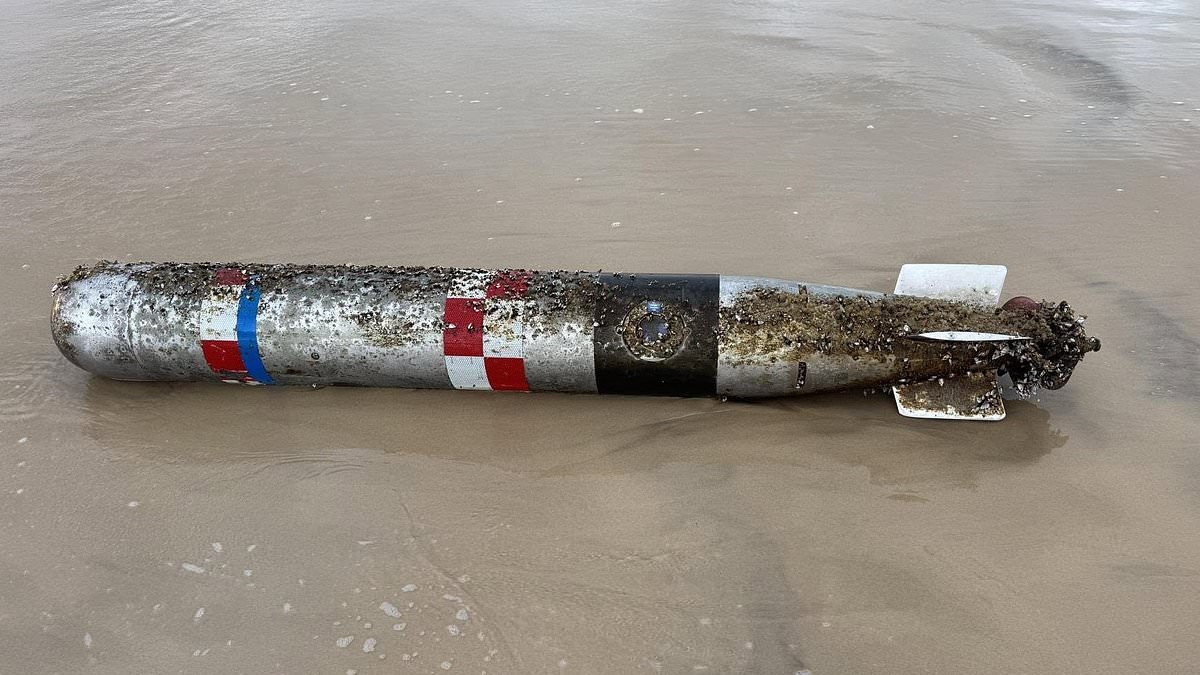An urgent police operation is underway at a popular Gold Coast beach after a suspected torpedo was found washed up on the shore.
The discovery follows the release of footage by Chinese state-run media showing live-fire exercises in the Tasman Sea, near busy airspace, leading to speculation that the suspected torpedo may be Chinese military equipment.
Queensland Police have established a 100-metre exclusion zone around the item, which was discovered at The Spit in Main Beach on Thursday morning.
Beachgoers reported that the cylinder-shaped object had washed up about 5.45am.
A Queensland Police Service spokesman said the object could be a ‘torpedo’.
‘We’re not sure whether it’s live or not,’ he said.
The spokesman confirmed the n Defence Force was notified of the discovery.
Members of the bomb squad attended the scene.
Sunrise reporter Georgia Costi shared a theory the apparent explosive could have been lost during military exercises.
‘This is an extremely strange set of circumstances, you definitely don’t see it every day here on the Gold Coast,’ she said.
‘All of this started about 5.45am … people walking along this very popular spot noticed what appears to be either a torpedo or a missile sitting on the sand.
‘It’s not uncommon to see military exercises off the Queensland coast. ‘That’s one potential theory about how it got here,’ she said.
The item was found about 300m south of the dredging pier at The Spit.
‘Police ask members of the public to avoid the area,’ Queensland Police said in a statement.
The discovery comes amid security tensions over a fleet of Chinese navy ships travelling down ‘s east coast.
Chinese state-run media released menacing footage of its live fire exercises in the Tasman Sea earlier this week, as more passengers planes were reportedly diverted while flying between and New Zealand.
Military exercises conducted by three Chinese warships 640 kilometres off the NSW south coast resulted in 49 aircraft being forced to change course last Friday.
The drills took place in the Tasman Sea beneath an area of busy airspace between and New Zealand.
Airservices officials told Senate estimates hearings on Monday that a Virgin pilot was the one to sound the alert after overhearing chatter from the ships while flying nearby.
‘It was in fact a Virgin aircraft that advised one of our air traffic controllers that a foreign warship was broadcasting, that they were conducting live firing 300 nautical miles east of our coast,’ chief executive Rob Sharp said.
‘So that’s how we first found out about the issue.’
China has insisted it issued ‘repeated safety notices’ before blasting missiles into the sea.
‘The Chinese side’s actions were entirely in accordance with international law and in line with international practices, which would not impact aviation safety,’ China’s Defence Ministry spokesman Wu Qian said.
On Tuesday, several Air New Zealand flights were forced to alter their flight path.
Just hours later, the state-run China Central Television (CCTV) released footage of the live firing exercises.
The vessels involved are Jiangkai-class frigate Hengyang, the Renhai-class destroyer Zunyi and the Fuchi-class replenishment vessel Weishanhu have been conducting live firing exercises in the Tasman Sea.
New Zealand’s Defence Minister Judith Collins warned that the warships are ‘extremely capable’ with a range of about 1,000km.
‘One has 112 vertical launch cells and has reported anti-ship ballistic missile range of 540 nautical miles,’ she said on Monday.
That military might was certainly on display in the footage shared by CCTV.
It showed Chinese navy officers sprinting up stairs on one of the vessels before one of the commanders ominously placed his thumb on a red button.
The clip then cut to the foredeck of the destroyer Zunyi, where a large-calibre anti-ship naval gun fired repeated rounds of ammunition into the sea.
A still image showed at least ten empty munitions’ shells scattered on the deck.
The exercise took place in international waters, so did not breach international law, but Anthony Albanese and Defence Minister Richard Marles both said China had not given sufficient warning.
‘They [China] did so with very little notice and that was the issue that was very disconcerting for the airlines involved,’ Mr Marles said.
‘We [] would typically give 12 to 24 hours’ notice, which enables aircraft that are going to potentially be in the vicinity to make plans to fly around.
‘It’s the responsibility of any navy, any military, to make sure when you then do undertake any live firing you are doing so in a manner which is safe relative to any commercial traffic, be it sea or air, which is in the vicinity.’
On Saturday, the Chinese ships performed a second live-firing exercise in the Tasman Sea.
Their actions were followed by accusation from China on Sunday that was ‘hyping up’ the live firing exercises.
The claim was seemingly in response to complaints.
Mr Wu said ‘s description of the events was ‘completely inconsistent with the facts’.
Mr Wu insisted that China had issued repeated safety notices before the exercises, though she did not specify how much notice was given.
‘China’s actions are in full compliance with international law and international practices and will not affect aviation flight safety,’ Ms Wu said in a statement.
‘, knowing this well, made unreasonable accusations against China and deliberately hyped it up. We are deeply surprised and strongly dissatisfied with this.’
